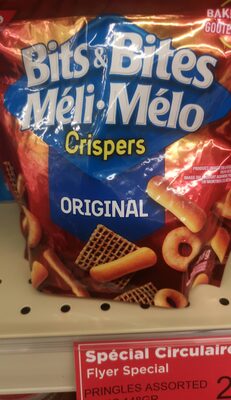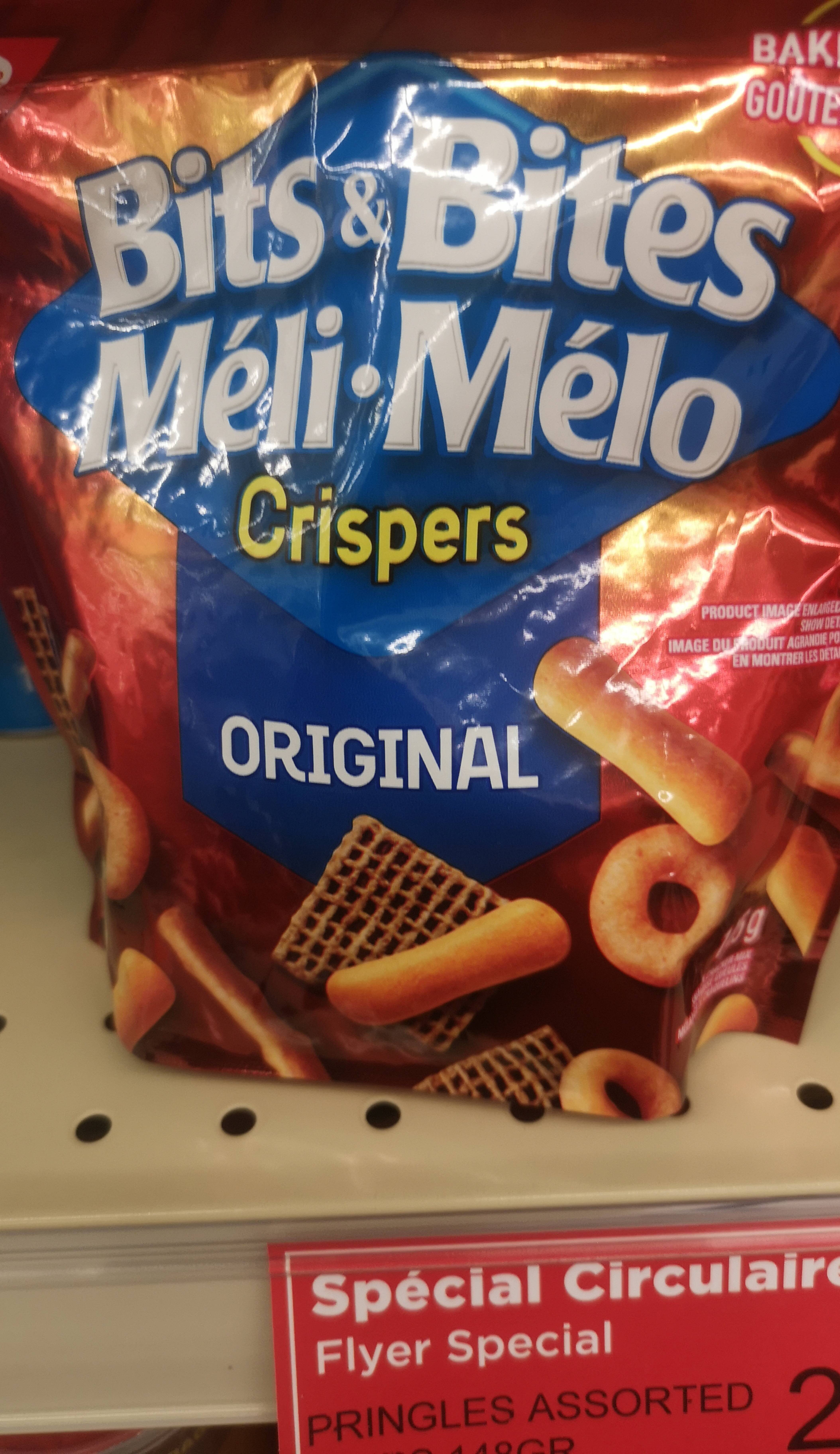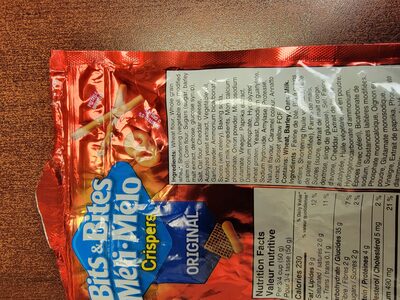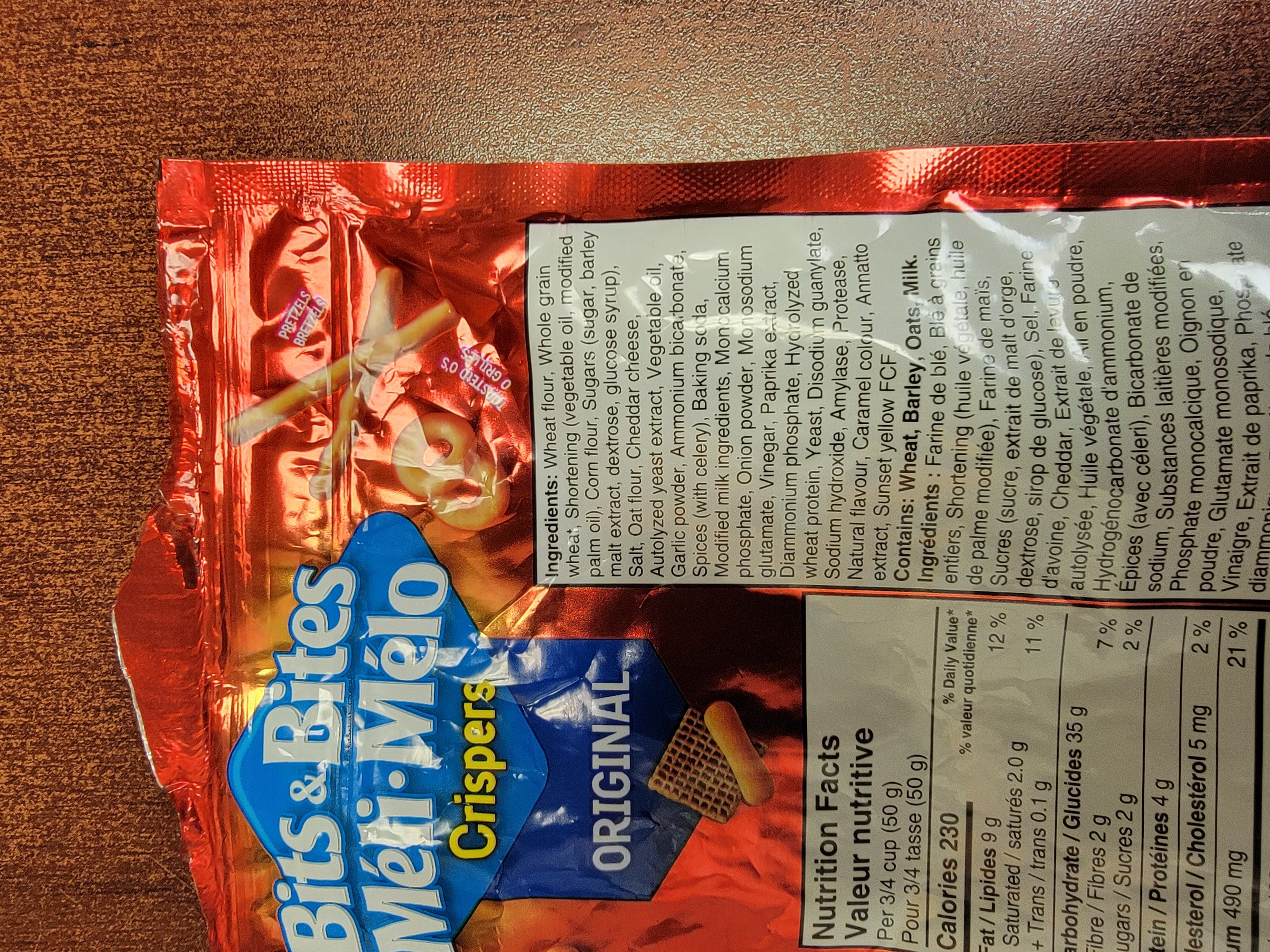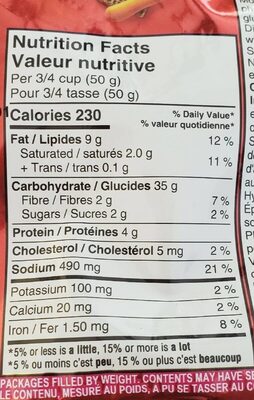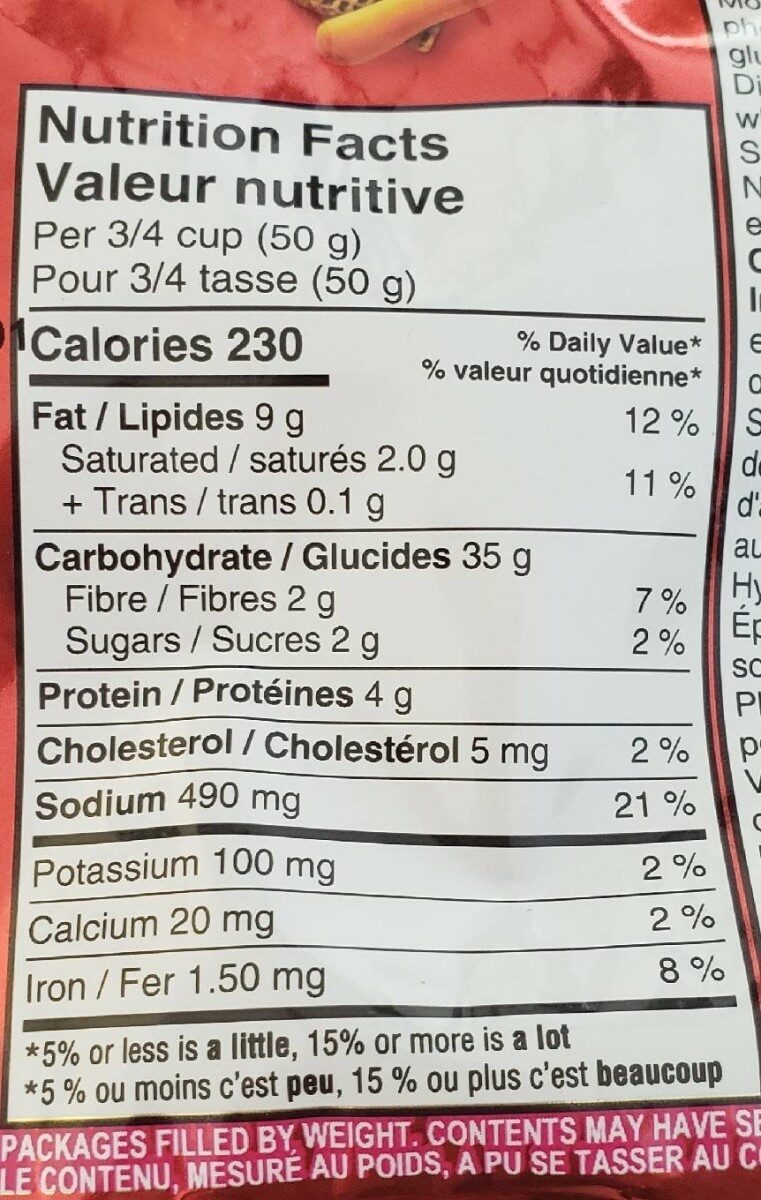Help us make food transparency the norm!
As a non-profit organization, we depend on your donations to continue informing consumers around the world about what they eat.
The food revolution starts with you!
Bits & Bites Crispers Original - Christie - 145 g
Bits & Bites Crispers Original - Christie - 145 g
This product page is not complete. You can help to complete it by editing it and adding more data from the photos we have, or by taking more photos using the app for Android or iPhone/iPad. Thank you!
×
Barcode: 0066721027412 (EAN / EAN-13) 066721027412 (UPC / UPC-A)
Quantity: 145 g
Brands: Christie
Categories: Snack and cracker mix
Countries where sold: Canada
Matching with your preferences
Health
Ingredients
-
39 ingredients
wheat flour, whole grain wheat, shortening (vegetable oil, modified palm oil), corn flour, sugars (sugar, barley malt extract, dextrose, glucose syrup), salt, oat flour, cheddar cheese, autolyzed yeast extract, vegetable oil, garlic powder, ammonium bicarbonate, spices (with celery), baking soda, modified milk ingredients, mono calcium phosphate, onion powder, monosodium glutamate, vinegar, paprika etract, diammonium phosphate, hycrolyzed wheat protein, yeast, disodium guanylate, sodium hydroxide, amylase, protease, natural flavour, caramel colour, annatto extract, sunset yellow fcf, originalAllergens: Gluten
Food processing
-
Ultra processed foods
Elements that indicate the product is in the 4 - Ultra processed food and drink products group:
- Additive: E110 - Sunset yellow FCF
- Additive: E150c - Ammonia caramel
- Additive: E621 - Monosodium glutamate
- Additive: E627 - Disodium guanylate
- Ingredient: Dextrose
- Ingredient: Flavouring
- Ingredient: Glucose
- Ingredient: Glucose syrup
Food products are classified into 4 groups according to their degree of processing:
- Unprocessed or minimally processed foods
- Processed culinary ingredients
- Processed foods
- Ultra processed foods
The determination of the group is based on the category of the product and on the ingredients it contains.
Additives
-
E110 - Sunset yellow FCF
Sunset Yellow FCF: Sunset Yellow FCF -also known as Orange Yellow S, or C.I. 15985- is a petroleum-derived orange azo dye with a pH dependent maximum absorption at about 480 nm at pH 1 and 443 nm at pH 13 with a shoulder at 500 nm. When added to foods sold in the US it is known as FD&C Yellow 6; when sold in Europe, it is denoted by E Number E110.Source: Wikipedia
-
E1100 - Alpha-Amylase
Amylase: An amylase -- is an enzyme that catalyses the hydrolysis of starch into sugars. Amylase is present in the saliva of humans and some other mammals, where it begins the chemical process of digestion. Foods that contain large amounts of starch but little sugar, such as rice and potatoes, may acquire a slightly sweet taste as they are chewed because amylase degrades some of their starch into sugar. The pancreas and salivary gland make amylase -alpha amylase- to hydrolyse dietary starch into disaccharides and trisaccharides which are converted by other enzymes to glucose to supply the body with energy. Plants and some bacteria also produce amylase. As diastase, amylase was the first enzyme to be discovered and isolated -by Anselme Payen in 1833-. Specific amylase proteins are designated by different Greek letters. All amylases are glycoside hydrolases and act on α-1‚4-glycosidic bonds.Source: Wikipedia
-
E1101 - Protease
Protease: A protease -also called a peptidase or proteinase- is an enzyme that performs proteolysis: protein catabolism by hydrolysis of peptide bonds. Proteases have evolved multiple times, and different classes of protease can perform the same reaction by completely different catalytic mechanisms. Proteases can be found in Animalia, Plantae, Fungi, Bacteria, Archaea and viruses.Source: Wikipedia
-
E341 - Calcium phosphates
Calcium phosphate: Calcium phosphate is a family of materials and minerals containing calcium ions -Ca2+- together with inorganic phosphate anions. Some so-called calcium phosphates contain oxide and hydroxide as well. They are white solids of nutritious value.Source: Wikipedia
-
E341i - Monocalcium phosphate
Calcium phosphate: Calcium phosphate is a family of materials and minerals containing calcium ions -Ca2+- together with inorganic phosphate anions. Some so-called calcium phosphates contain oxide and hydroxide as well. They are white solids of nutritious value.Source: Wikipedia
-
E500 - Sodium carbonates
Sodium carbonates (E500) are compounds commonly used in food preparation as leavening agents, helping baked goods rise by releasing carbon dioxide when they interact with acids.
Often found in baking soda, they regulate the pH of food, preventing it from becoming too acidic or too alkaline. In the culinary world, sodium carbonates can also enhance the texture and structure of foods, such as noodles, by modifying the gluten network.
Generally recognized as safe, sodium carbonates are non-toxic when consumed in typical amounts found in food.
-
E500ii - Sodium hydrogen carbonate
Sodium hydrogen carbonate, also known as E500ii, is a food additive commonly used as a leavening agent.
When added to recipes, it releases carbon dioxide gas upon exposure to heat or acids, causing dough to rise and resulting in a light, fluffy texture in baked goods.
It is generally recognized as safe (GRAS) by regulatory authorities when used in appropriate quantities and poses no significant health risks when consumed in typical food applications.
-
E503 - Ammonium carbonates
Ammonium carbonate: Ammonium carbonate is a salt with the chemical formula -NH4-2CO3. Since it readily degrades to gaseous ammonia and carbon dioxide upon heating, it is used as a leavening agent and also as smelling salt. It is also known as baker's ammonia and was a predecessor to the more modern leavening agents baking soda and baking powder. It is a component of what was formerly known as sal volatile and salt of hartshorn.Source: Wikipedia
-
E503ii - Ammonium hydrogen carbonate
Ammonium carbonate: Ammonium carbonate is a salt with the chemical formula -NH4-2CO3. Since it readily degrades to gaseous ammonia and carbon dioxide upon heating, it is used as a leavening agent and also as smelling salt. It is also known as baker's ammonia and was a predecessor to the more modern leavening agents baking soda and baking powder. It is a component of what was formerly known as sal volatile and salt of hartshorn.Source: Wikipedia
-
E524 - Sodium hydroxide
Sodium hydroxide: Sodium hydroxide, also known as lye and caustic soda, is an inorganic compound with the formula NaOH. It is a white solid ionic compound consisting of sodium cations Na+ and hydroxide anions OH−. Sodium hydroxide is a highly caustic base and alkali that decomposes proteins at ordinary ambient temperatures and may cause severe chemical burns. It is highly soluble in water, and readily absorbs moisture and carbon dioxide from the air. It forms a series of hydrates NaOH·nH2O. The monohydrate NaOH·H2O crystallizes from water solutions between 12.3 and 61.8 °C. The commercially available "sodium hydroxide" is often this monohydrate, and published data may refer to it instead of the anhydrous compound. As one of the simplest hydroxides, it is frequently utilized alongside neutral water and acidic hydrochloric acid to demonstrate the pH scale to chemistry students.Sodium hydroxide is used in many industries: in the manufacture of pulp and paper, textiles, drinking water, soaps and detergents, and as a drain cleaner. Worldwide production in 2004 was approximately 60 million tonnes, while demand was 51 million tonnes.Source: Wikipedia
-
E621 - Monosodium glutamate
Monosodium glutamate: Monosodium glutamate -MSG, also known as sodium glutamate- is the sodium salt of glutamic acid, one of the most abundant naturally occurring non-essential amino acids. Glutamic acid is found naturally in tomatoes, grapes, cheese, mushrooms and other foods.MSG is used in the food industry as a flavor enhancer with an umami taste that intensifies the meaty, savory flavor of food, as naturally occurring glutamate does in foods such as stews and meat soups. It was first prepared in 1908 by Japanese biochemist Kikunae Ikeda, who was trying to isolate and duplicate the savory taste of kombu, an edible seaweed used as a base for many Japanese soups. MSG as a flavor enhancer balances, blends, and rounds the perception of other tastes.The U.S. Food and Drug Administration has given MSG its generally recognized as safe -GRAS- designation. A popular belief is that large doses of MSG can cause headaches and other feelings of discomfort, known as "Chinese restaurant syndrome," but double-blind tests fail to find evidence of such a reaction. The European Union classifies it as a food additive permitted in certain foods and subject to quantitative limits. MSG has the HS code 29224220 and the E number E621.Source: Wikipedia
-
E627 - Disodium guanylate
Disodium guanylate: Disodium guanylate, also known as sodium 5'-guanylate and disodium 5'-guanylate, is a natural sodium salt of the flavor enhancing nucleotide guanosine monophosphate -GMP-. Disodium guanylate is a food additive with the E number E627. It is commonly used in conjunction with glutamic acid. As it is a fairly expensive additive, it is not used independently of glutamic acid; if disodium guanylate is present in a list of ingredients but MSG does not appear to be, it is likely that glutamic acid is provided as part of another ingredient such as a processed soy protein complex. It is often added to foods in conjunction with disodium inosinate; the combination is known as disodium 5'-ribonucleotides. Disodium guanylate is produced from dried seaweed and is often added to instant noodles, potato chips and other snacks, savory rice, tinned vegetables, cured meats, and packaged soup.Source: Wikipedia
Ingredients analysis
-
Palm oil
Ingredients that contain palm oil: Modified palm oil
-
Non-vegan
Non-vegan ingredients: Cheddar, Modified milk ingredientsSome ingredients could not be recognized.
We need your help!
You can help us recognize more ingredients and better analyze the list of ingredients for this product and others:
- Edit this product page to correct spelling mistakes in the ingredients list, and/or to remove ingredients in other languages and sentences that are not related to the ingredients.
- Add new entries, synonyms or translations to our multilingual lists of ingredients, ingredient processing methods, and labels.
If you would like to help, join the #ingredients channel on our Slack discussion space and/or learn about ingredients analysis on our wiki. Thank you!
-
Vegetarian status unknown
Unrecognized ingredients: Paprika-etract, Hycrolyzed-wheat-protein, OriginalSome ingredients could not be recognized.
We need your help!
You can help us recognize more ingredients and better analyze the list of ingredients for this product and others:
- Edit this product page to correct spelling mistakes in the ingredients list, and/or to remove ingredients in other languages and sentences that are not related to the ingredients.
- Add new entries, synonyms or translations to our multilingual lists of ingredients, ingredient processing methods, and labels.
If you would like to help, join the #ingredients channel on our Slack discussion space and/or learn about ingredients analysis on our wiki. Thank you!
-
Details of the analysis of the ingredients
We need your help!
Some ingredients could not be recognized.
We need your help!
You can help us recognize more ingredients and better analyze the list of ingredients for this product and others:
- Edit this product page to correct spelling mistakes in the ingredients list, and/or to remove ingredients in other languages and sentences that are not related to the ingredients.
- Add new entries, synonyms or translations to our multilingual lists of ingredients, ingredient processing methods, and labels.
If you would like to help, join the #ingredients channel on our Slack discussion space and/or learn about ingredients analysis on our wiki. Thank you!
en: wheat flour, whole grain wheat, shortening (vegetable oil, modified palm oil), corn flour, sugars (sugar, barley malt extract, dextrose, glucose syrup), salt, oat flour, cheddar cheese, autolyzed yeast extract, vegetable oil, garlic, ammonium bicarbonate, spices (with celery), baking soda, modified milk ingredients, mono- calcium phosphate, onion, monosodium glutamate, vinegar, paprika etract, diammonium phosphate, hycrolyzed wheat protein, yeast, disodium guanylate, sodium hydroxide, amylase, protease, natural flavour, caramel colour, annatto, sunset yellow fcf, original- wheat flour -> en:wheat-flour - vegan: yes - vegetarian: yes - ciqual_proxy_food_code: 9410 - percent_min: 3.125 - percent_max: 100
- whole grain wheat -> en:whole-wheat - vegan: yes - vegetarian: yes - ciqual_food_code: 9010 - percent_min: 0 - percent_max: 50
- shortening -> en:fat - vegan: maybe - vegetarian: maybe - from_palm_oil: maybe - percent_min: 0 - percent_max: 33.3333333333333
- vegetable oil -> en:vegetable-oil - vegan: yes - vegetarian: yes - from_palm_oil: maybe - percent_min: 0 - percent_max: 33.3333333333333
- modified palm oil -> en:modified-palm-oil - vegan: yes - vegetarian: yes - from_palm_oil: yes - ciqual_food_code: 16129 - percent_min: 0 - percent_max: 16.6666666666667
- corn flour -> en:corn-flour - vegan: yes - vegetarian: yes - ciqual_food_code: 9545 - percent_min: 0 - percent_max: 25
- sugars -> en:sugar - vegan: yes - vegetarian: yes - ciqual_proxy_food_code: 31016 - percent_min: 0 - percent_max: 4
- sugar -> en:sugar - vegan: yes - vegetarian: yes - ciqual_proxy_food_code: 31016 - percent_min: 0 - percent_max: 4
- barley malt extract -> en:barley-malt-extract - vegan: yes - vegetarian: yes - percent_min: 0 - percent_max: 2
- dextrose -> en:dextrose - vegan: yes - vegetarian: yes - ciqual_proxy_food_code: 31016 - percent_min: 0 - percent_max: 1.33333333333333
- glucose syrup -> en:glucose-syrup - vegan: yes - vegetarian: yes - ciqual_proxy_food_code: 31016 - percent_min: 0 - percent_max: 1
- salt -> en:salt - vegan: yes - vegetarian: yes - ciqual_food_code: 11058 - percent_min: 0 - percent_max: 4
- oat flour -> en:oat-flour - vegan: yes - vegetarian: yes - ciqual_food_code: 9310 - percent_min: 0 - percent_max: 4
- cheddar cheese -> en:cheddar - vegan: no - vegetarian: maybe - ciqual_food_code: 12726 - percent_min: 0 - percent_max: 4
- autolyzed yeast extract -> en:autolyzed-yeast-extract - vegan: yes - vegetarian: yes - ciqual_proxy_food_code: 11009 - percent_min: 0 - percent_max: 4
- vegetable oil -> en:vegetable-oil - vegan: yes - vegetarian: yes - from_palm_oil: maybe - percent_min: 0 - percent_max: 4
- garlic -> en:garlic - vegan: yes - vegetarian: yes - ciqual_food_code: 11000 - percent_min: 0 - percent_max: 4
- ammonium bicarbonate -> en:e503ii - vegan: yes - vegetarian: yes - percent_min: 0 - percent_max: 4
- spices -> en:spice - vegan: yes - vegetarian: yes - percent_min: 0 - percent_max: 4
- with celery -> en:celery - vegan: yes - vegetarian: yes - ciqual_proxy_food_code: 20055 - percent_min: 0 - percent_max: 4
- baking soda -> en:e500ii - vegan: yes - vegetarian: yes - percent_min: 0 - percent_max: 4
- modified milk ingredients -> en:modified-milk-ingredients - vegan: no - vegetarian: yes - ciqual_proxy_food_code: 19051 - percent_min: 0 - percent_max: 4
- mono- calcium phosphate -> en:e341i - vegan: yes - vegetarian: yes - percent_min: 0 - percent_max: 4
- onion -> en:onion - vegan: yes - vegetarian: yes - ciqual_food_code: 20034 - percent_min: 0 - percent_max: 4
- monosodium glutamate -> en:e621 - vegan: yes - vegetarian: yes - percent_min: 0 - percent_max: 4
- vinegar -> en:vinegar - vegan: yes - vegetarian: yes - ciqual_food_code: 11018 - percent_min: 0 - percent_max: 4
- paprika etract -> en:paprika-etract - percent_min: 0 - percent_max: 4
- diammonium phosphate -> en:e342 - vegan: yes - vegetarian: yes - percent_min: 0 - percent_max: 4
- hycrolyzed wheat protein -> en:hycrolyzed-wheat-protein - percent_min: 0 - percent_max: 4
- yeast -> en:yeast - vegan: yes - vegetarian: yes - ciqual_proxy_food_code: 11009 - percent_min: 0 - percent_max: 4
- disodium guanylate -> en:e627 - vegan: maybe - vegetarian: maybe - percent_min: 0 - percent_max: 4
- sodium hydroxide -> en:e524 - vegan: yes - vegetarian: yes - percent_min: 0 - percent_max: 4
- amylase -> en:e1100 - vegan: yes - vegetarian: yes - percent_min: 0 - percent_max: 3.84615384615385
- protease -> en:e1101 - vegan: yes - vegetarian: yes - percent_min: 0 - percent_max: 3.7037037037037
- natural flavour -> en:natural-flavouring - vegan: maybe - vegetarian: maybe - percent_min: 0 - percent_max: 3.57142857142857
- caramel colour -> en:e150a - vegan: yes - vegetarian: yes - percent_min: 0 - percent_max: 3.44827586206897
- annatto -> en:e160b - vegan: yes - vegetarian: yes - percent_min: 0 - percent_max: 3.33333333333333
- sunset yellow fcf -> en:e110 - vegan: yes - vegetarian: yes - percent_min: 0 - percent_max: 3.2258064516129
- original -> en:original - percent_min: 0 - percent_max: 3.125
Nutrition
-
Poor nutritional quality
⚠ ️Warning: the amount of fruits, vegetables and nuts is not specified on the label, it was estimated from the list of ingredients: 0This product is not considered a beverage for the calculation of the Nutri-Score.
Positive points: 4
- Proteins: 4 / 5 (value: 8, rounded value: 8)
- Fiber: 4 / 5 (value: 4, rounded value: 4)
- Fruits, vegetables, nuts, and colza/walnut/olive oils: 0 / 5 (value: 0.01605224609375, rounded value: 0)
Negative points: 18
- Energy: 5 / 10 (value: 1920, rounded value: 1920)
- Sugars: 0 / 10 (value: 4, rounded value: 4)
- Saturated fat: 3 / 10 (value: 4, rounded value: 4)
- Sodium: 10 / 10 (value: 980, rounded value: 980)
The points for proteins are not counted because the negative points are greater or equal to 11.
Nutritional score: (18 - 4)
Nutri-Score:
-
Nutrient levels
-
Fat in moderate quantity (18%)
What you need to know- A high consumption of fat, especially saturated fats, can raise cholesterol, which increases the risk of heart diseases.
Recommendation: Limit the consumption of fat and saturated fat- Choose products with lower fat and saturated fat content.
-
Saturated fat in moderate quantity (4%)
What you need to know- A high consumption of fat, especially saturated fats, can raise cholesterol, which increases the risk of heart diseases.
Recommendation: Limit the consumption of fat and saturated fat- Choose products with lower fat and saturated fat content.
-
Sugars in low quantity (4%)
What you need to know- A high consumption of sugar can cause weight gain and tooth decay. It also augments the risk of type 2 diabetes and cardio-vascular diseases.
Recommendation: Limit the consumption of sugar and sugary drinks- Sugary drinks (such as sodas, fruit beverages, and fruit juices and nectars) should be limited as much as possible (no more than 1 glass a day).
- Choose products with lower sugar content and reduce the consumption of products with added sugars.
-
Salt in high quantity (2.45%)
What you need to know- A high consumption of salt (or sodium) can cause raised blood pressure, which can increase the risk of heart disease and stroke.
- Many people who have high blood pressure do not know it, as there are often no symptoms.
- Most people consume too much salt (on average 9 to 12 grams per day), around twice the recommended maximum level of intake.
Recommendation: Limit the consumption of salt and salted food- Reduce the quantity of salt used when cooking, and don't salt again at the table.
- Limit the consumption of salty snacks and choose products with lower salt content.
-
-
Nutrition facts
Nutrition facts As sold
for 100 g / 100 mlAs sold
per serving (50 g)Energy 1,920 kj
(460 kcal)962 kj
(230 kcal)Fat 18 g 9 g Saturated fat 4 g 2 g Trans fat 0.2 g 0.1 g Cholesterol 10 mg 5 mg Carbohydrates 70 g 35 g Sugars 4 g 2 g Fiber 4 g 2 g Proteins 8 g 4 g Salt 2.45 g 1.225 g Potassium 200 mg 100 mg Calcium 40 mg 20 mg Iron 3 mg 1.5 mg Fruits‚ vegetables‚ nuts and rapeseed‚ walnut and olive oils (estimate from ingredients list analysis) 0.016 % 0.016 %
Environment
-
Eco-Score not computed - Unknown environmental impact
We could not compute the Eco-Score of this product as it is missing some data, could you help complete it?Could you add a precise product category so that we can compute the Eco-Score? Add a category
Packaging
-
Missing packaging information for this product
⚠ ️ The information about the packaging of this product is not filled in.Take a photo of the recycling information Take a photo of the recycling information
Transportation
-
Origins of ingredients
Missing origins of ingredients information
⚠ ️ The origins of the ingredients of this product are not indicated.
If they are indicated on the packaging, you can modify the product sheet and add them.
If you are the manufacturer of this product, you can send us the information with our free platform for producers.Add the origins of ingredients for this product Add the origins of ingredients for this product
Threatened species
-
Contains palm oil
Drives deforestation and threatens species such as the orangutan
Tropical forests in Asia, Africa and Latin America are destroyed to create and expand oil palm tree plantations. The deforestation contributes to climate change, and it endangers species such as the orangutan, the pigmy elephant and the Sumatran rhino.
Report a problem
-
Incomplete or incorrect information?
Category, labels, ingredients, allergens, nutritional information, photos etc.
If the information does not match the information on the packaging, please complete or correct it. Open Food Facts is a collaborative database, and every contribution is useful for all.
Data sources
Product added on by kiliweb
Last edit of product page on by sentientscythe.
Product page also edited by ecoscore-impact-estimator, foodless, inf, yuka.sY2b0xO6T85zoF3NwEKvln15CN-Gu23nKT_jnF-Gmvm_Dsbsbvgo-tj8Hao, yuka.sY2b0xO6T85zoF3NwEKvln5df9v9sgLGJwzvxmS7noihPMHESMFD7aHlNKs.
